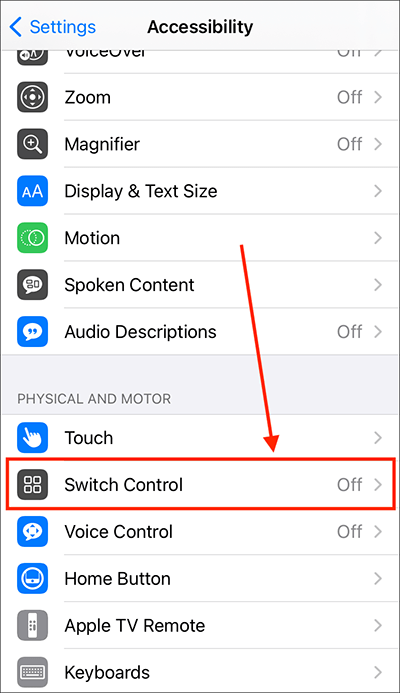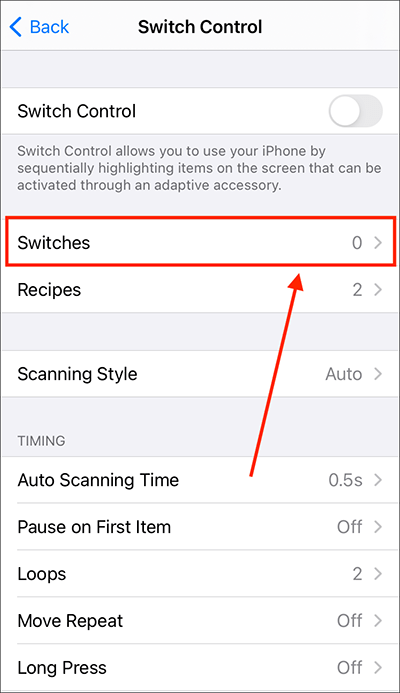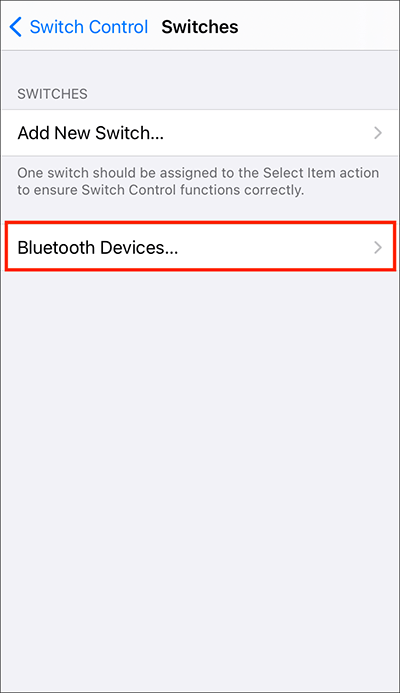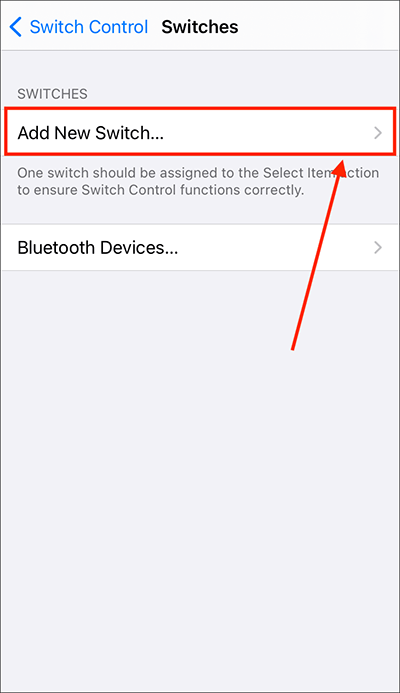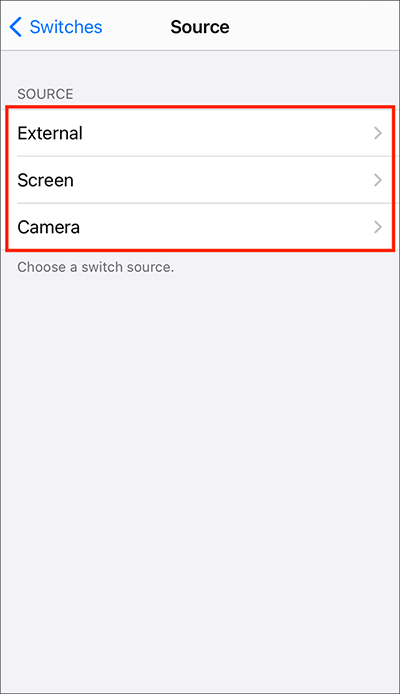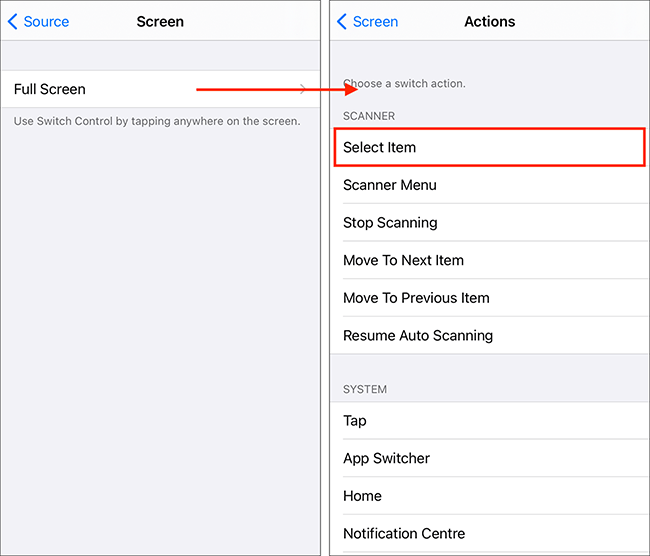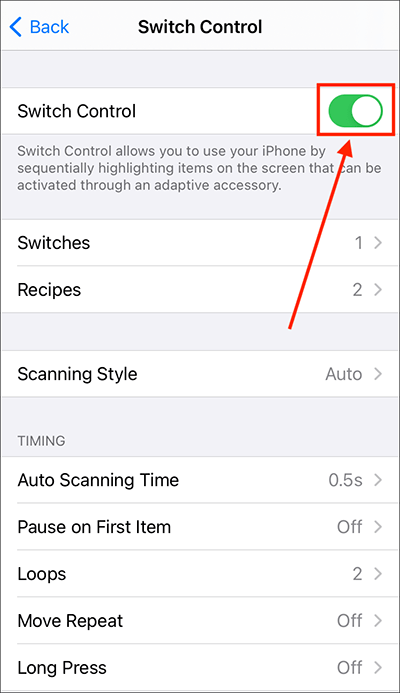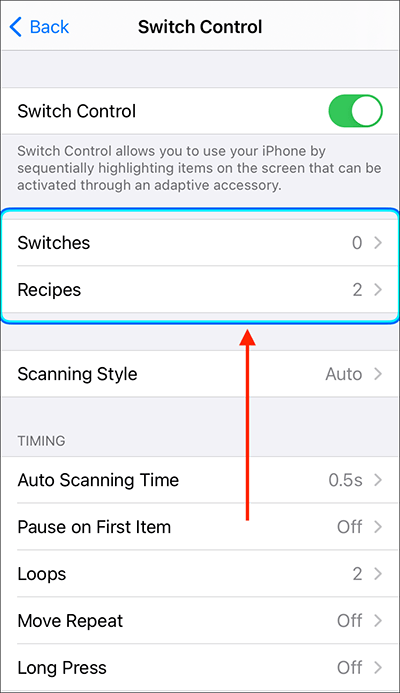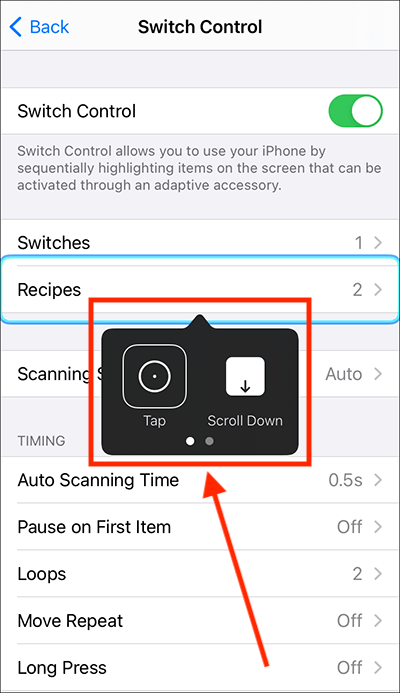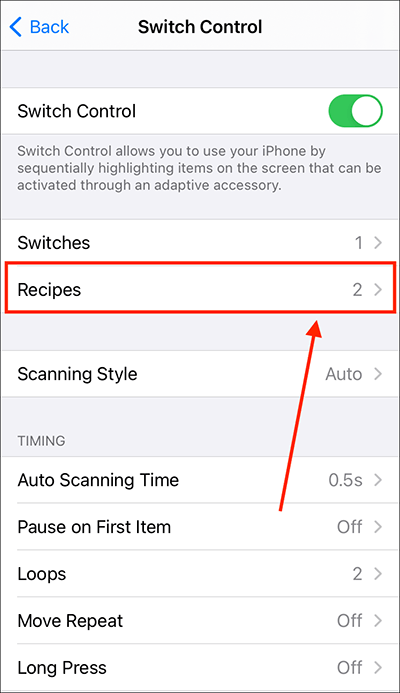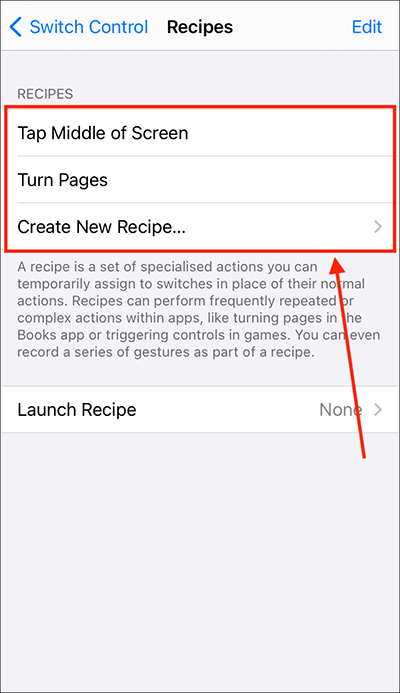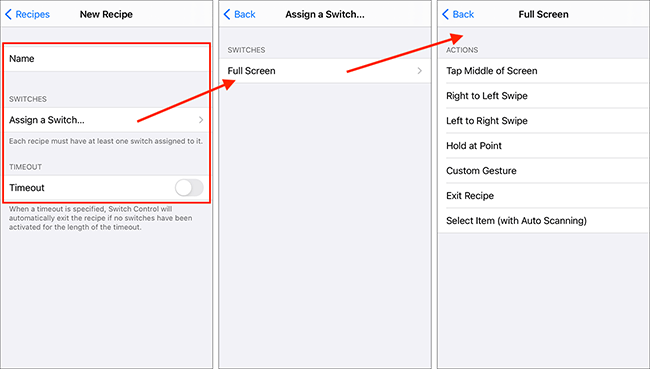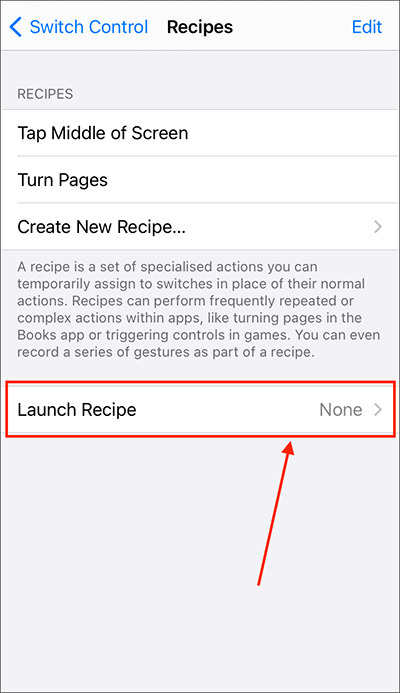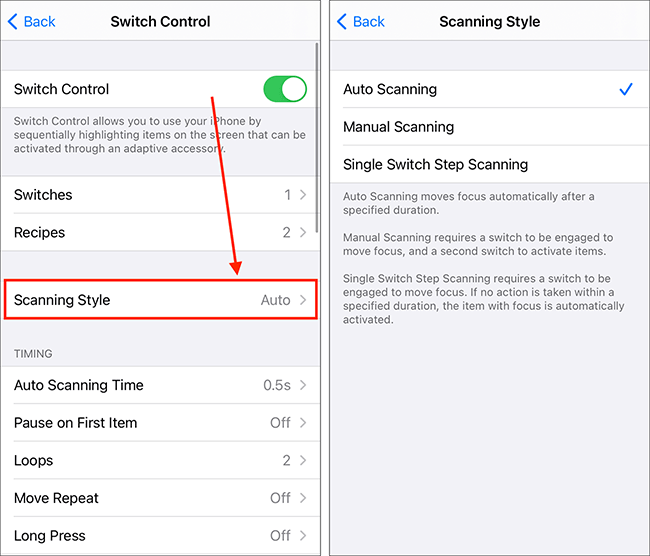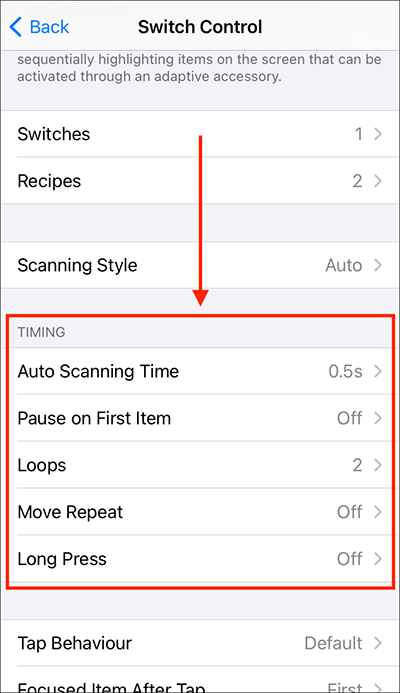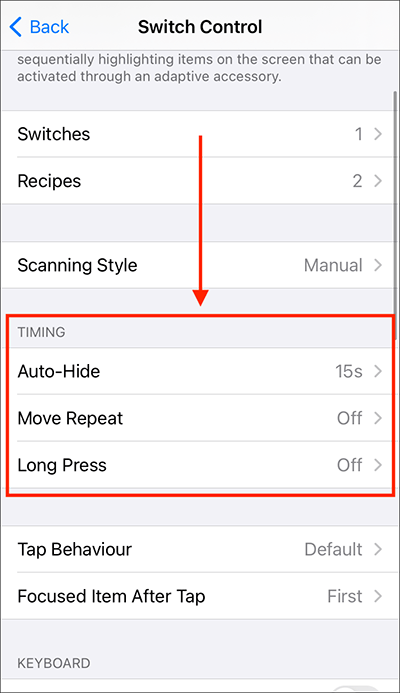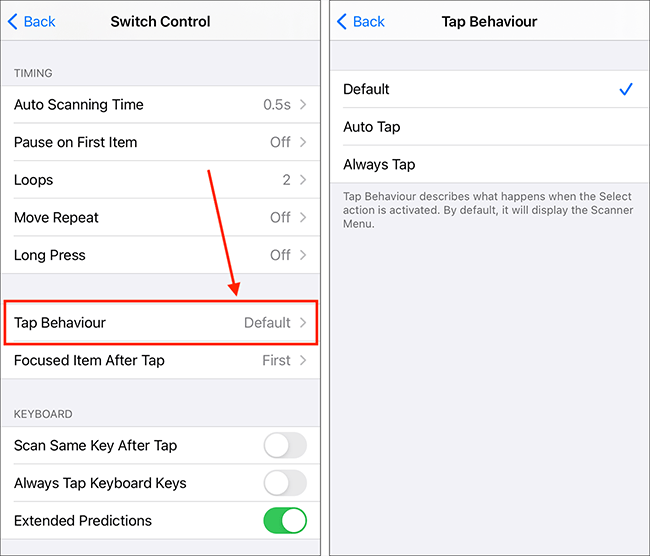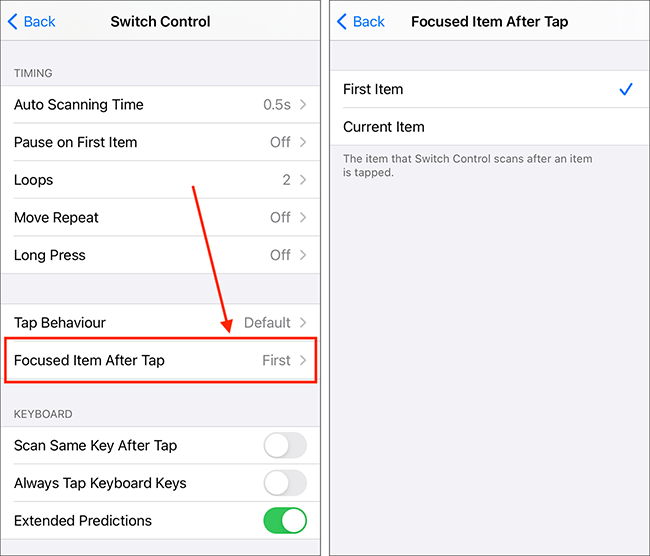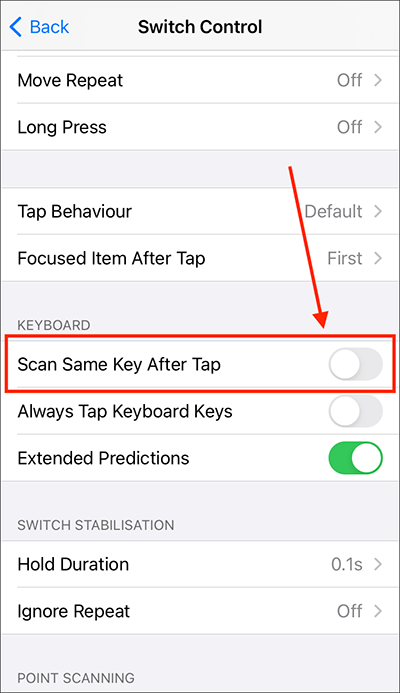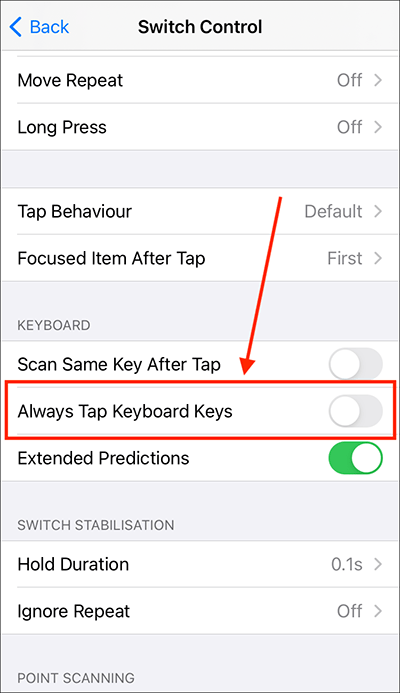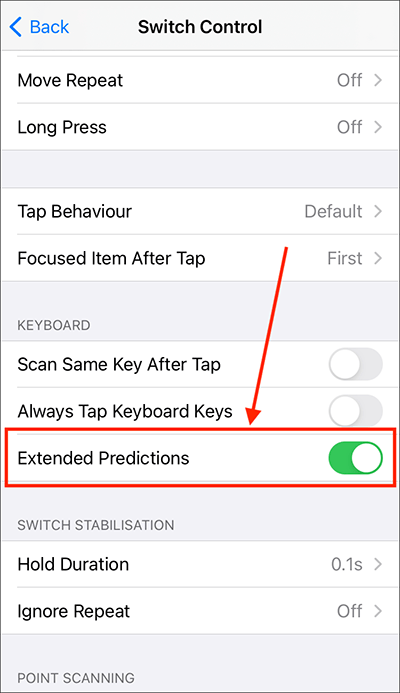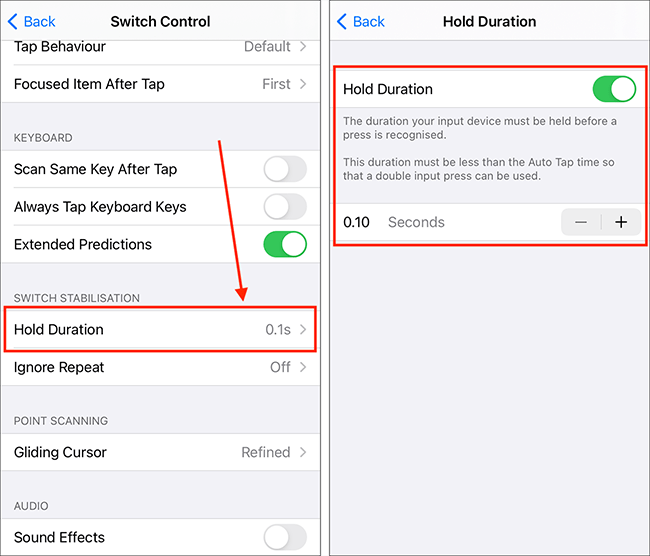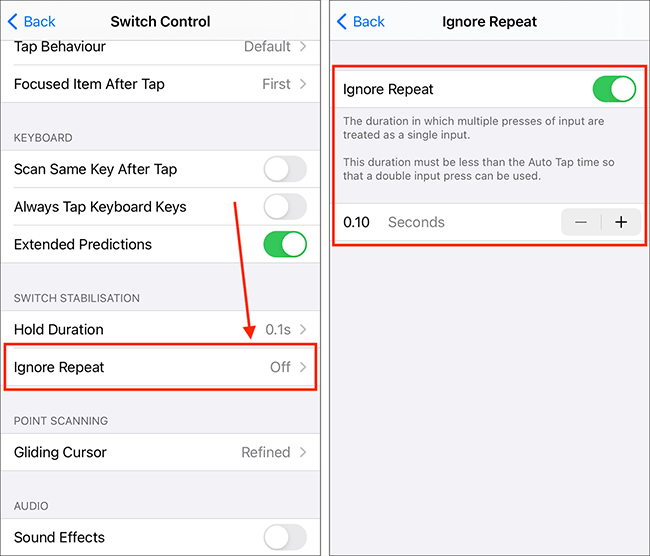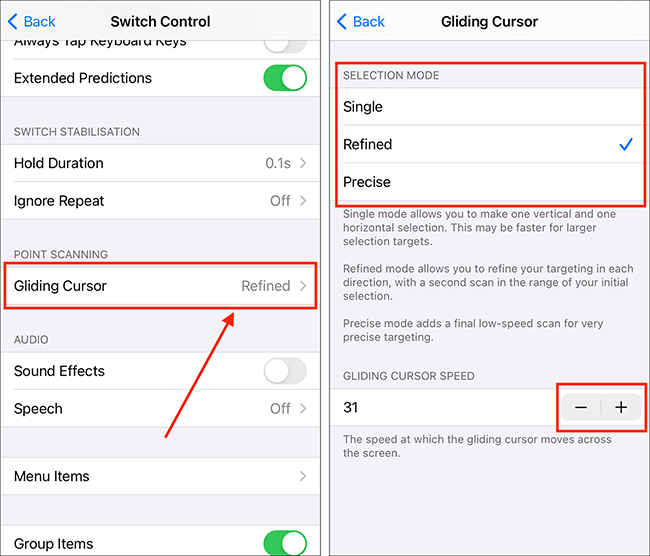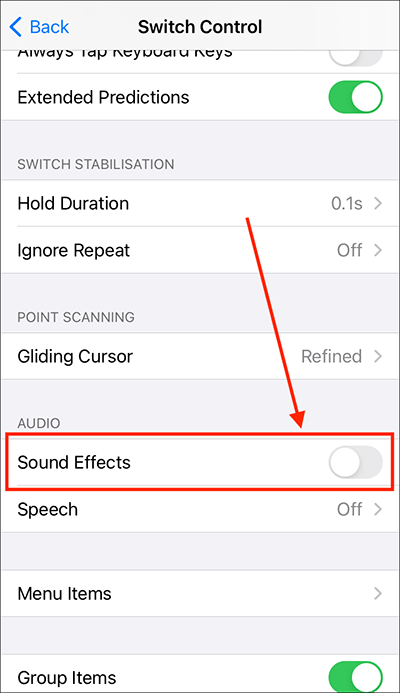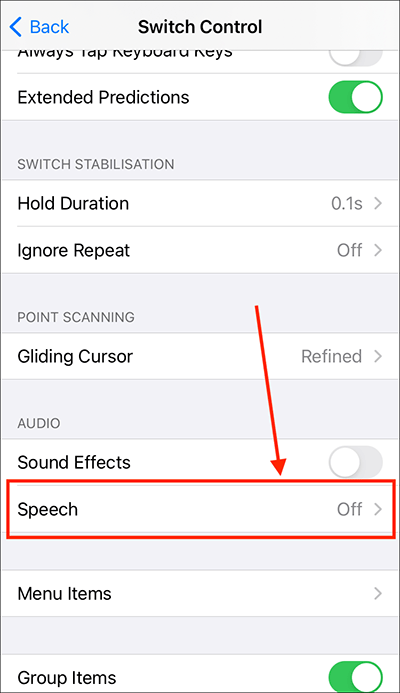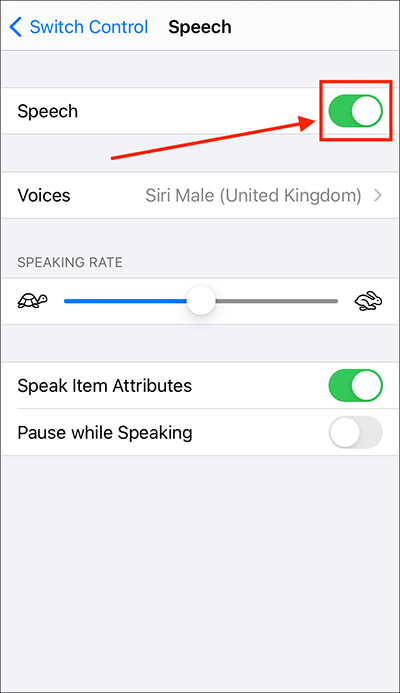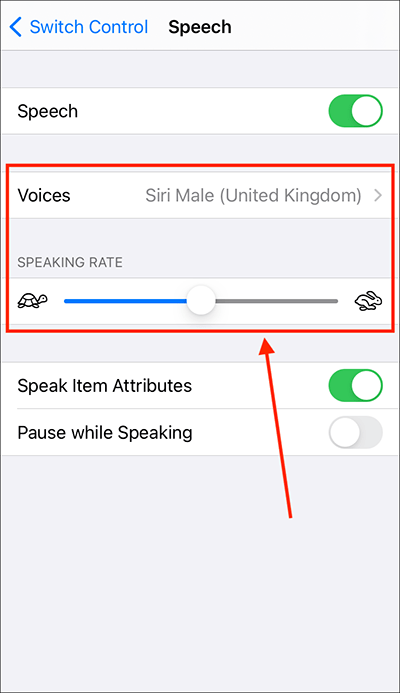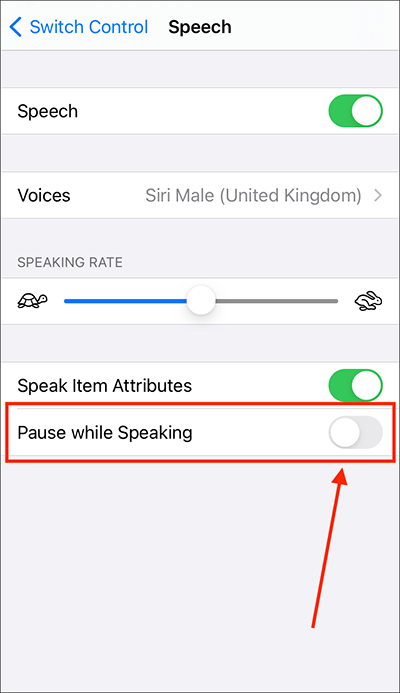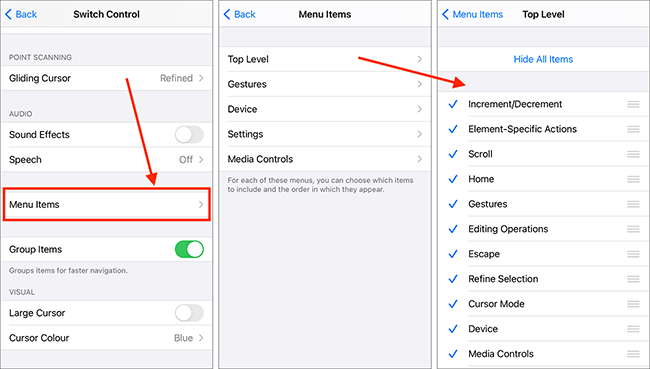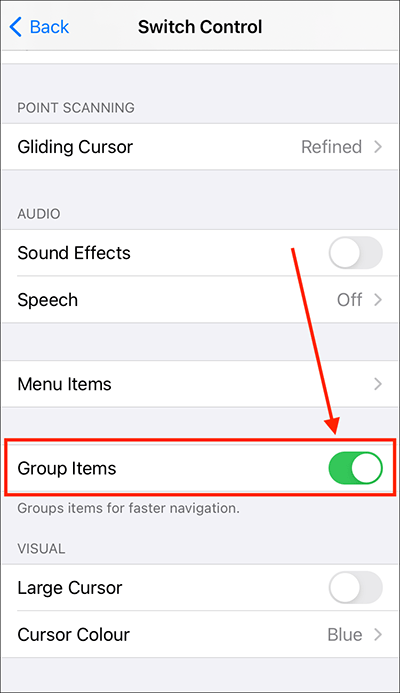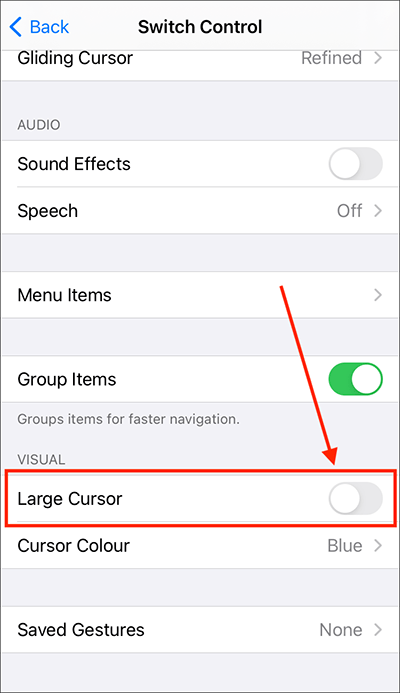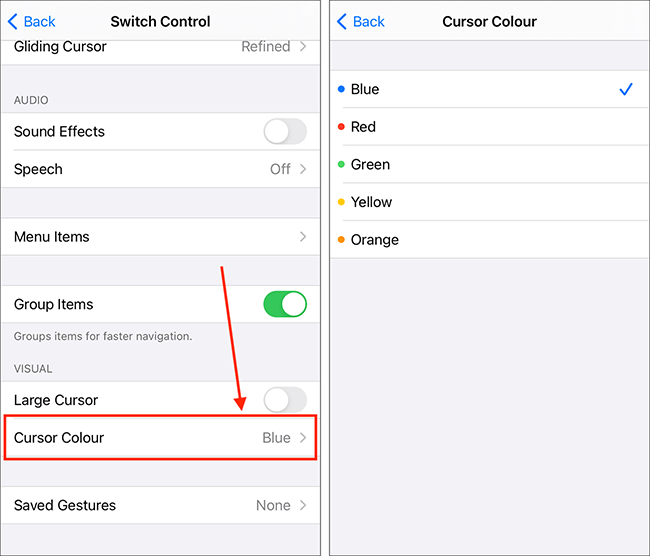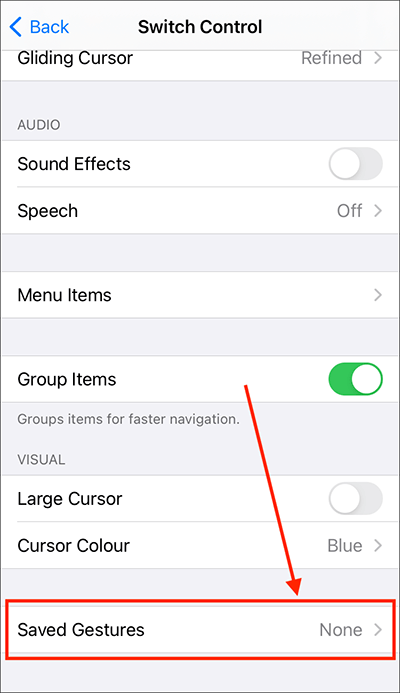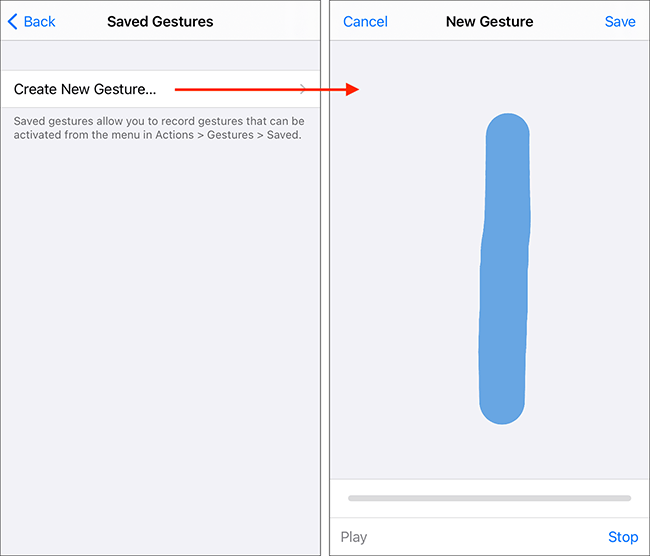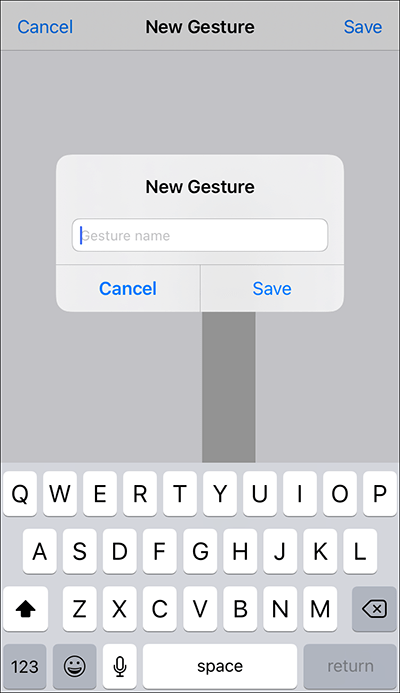In this article
How to enable Switch Control
Switch Control settings
How to enable Switch Control
- Open the Settings app
 . Note: The Settings app icon may appear in a different place on your home screen than shown in our example, below.
. Note: The Settings app icon may appear in a different place on your home screen than shown in our example, below.
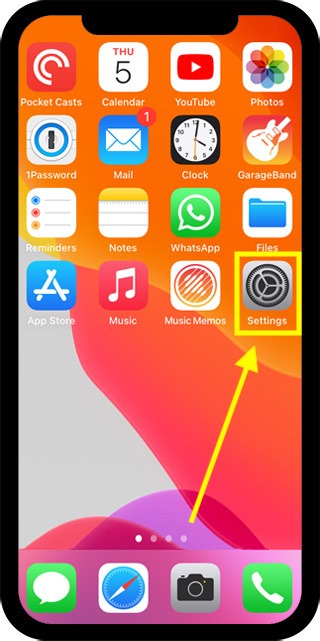
- In the Settings app, scroll down and select Accessibility from the list.
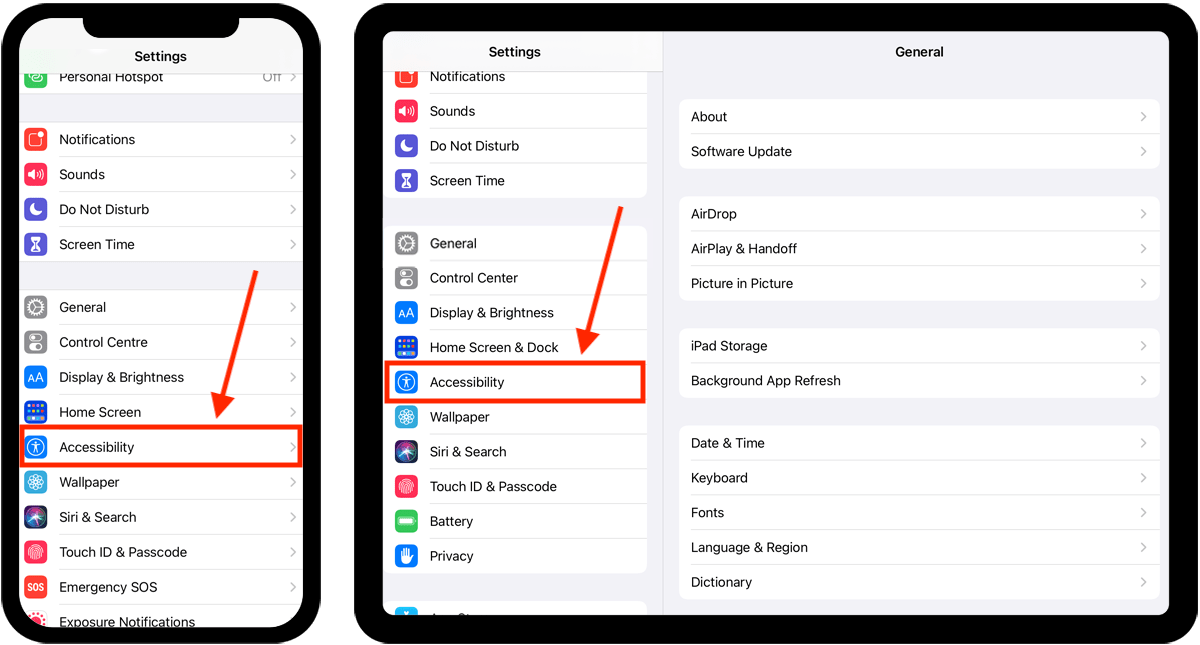
- On the Accessibility screen, select Switch Control.
- On the next screen, select Switches.
- If you are going to use a Bluetooth switch, select Bluetooth and follow the onscreen instruction to pair your device.
- Next, select Add New Switch to assign actions to your switches.
- Choose the switch you want to assign an action for. Choose from:
- External – your connected switch devices
- Screen – the whole screen becomes a switch
- Camera – the camera detects head movement to trigger switches.
- When you’ve chosen a switch (our example uses the Screen), click through to assign an action to it. At least one of your switches needs to be assigned, Select Item. Some switches can have a secondary action assigned to long press.
- Once you are happy with your switches, use the back buttons in the top-left corner to return to the main Switch Control screen.
- Set the toggle switch for Switch Control to On.
Once enabled, you can start scanning by activating your switch. The default is to scan through groups of items, then, when you select a group, it scans through the items within that group so that you can select a single ‘focused’ item. Use the switch assigned to Select Item to make your selections. The default is to loop through the scan twice then stop if no selection is made.
When you select a focused item, you will see the pop-up Scanning menu. This menu provides options for selecting the focused item (tap) and scrolling the page. You can access more actions by selecting the dots at the bottom of the menu.
Switch Control settings
- Open the Settings app
 . Note: The Settings app icon may appear in a different place on your home screen than shown in our example, below.
. Note: The Settings app icon may appear in a different place on your home screen than shown in our example, below.

- In the Settings app, scroll down and select Accessibility from the list.

- On the Accessibility screen, select Switch Control.
- You can now customise the following settings:
Switches
To add a new switch:
- Select Switches.
- If you are going to use a Bluetooth switch, select Bluetooth and follow the onscreen instruction to pair your device.
- Next, select Add New Switch to assign actions to your switches.
- Choose the switch you want to assign an action for. Choose from:
- External – your connected switch devices.
- Screen – the whole screen becomes a switch.
- Camera – the camera detects head movement to trigger switches.
- When you’ve chosen a switch (our example uses the Screen), click through to assign an action to it. At least one of your switches needs to be assigned Select Item. Some switches can have a secondary action assigned to long press.
Recipes
A recipe is a set of actions that you can temporarily assign to a switch instead of its normal behaviour. Recipes are very useful for performing repetitive actions such as turning the pages of an eBook - in fact, Apple has already created a ‘Turn Pages’ recipe for you. The recipes you create are added to the pop-up Scanning menu.
- Select Recipes.
- Choose an existing recipe to assign a switch to it or choose Create New Recipe.
- When creating a new recipe, first select a switch and then choose the action to assign it.
- If you would like one of your recipes to launch automatically when Switch Control starts, select Launch Recipe, then select a recipe.
Scanning Style
There are three ways of scanning. Select Scanning Style and choose from:
- Auto Scanning – move automatically from one item to the next after a specified duration.
- Manual Scanning – this requires two switches, one to move through items and a second to activate items.
- Single Switch Step Scanning – use a switch to move through items one at a time. If a switch isn’t pressed within a specified duration, the item currently highlighted is activated.
Timing
The timing options are different depending on which scanning style you choose.
(Timing) Auto Scanning Mode options
- Auto Scanning Time – this is the speed at which the scanning cursor cycles through items.
- Pause on First Item – this is how long scanning pauses on the first item before starting to cycle through all items.
- Loops – the number of times scanning cycles through items before stopping and hiding the cursor. The default is two loops.
- Move Repeat – when you hold down a switch the Move To Next / Previous item action is repeated. This is enabled by default.
- Long Press – when you set up a switch (see Switches, above), you may see an option to associate an action with a long press. This enables you to add a second action to the same switch which you activate by holding the switch for a set duration. If you have switches with long press actions, you will need to enable the long press functionality here. You can then set how long you need to hold the switch to activate a long press action.
(Timing) Manual Scanning options
- Auto-Hide – the time it takes for the scanner interface to disappear due to inactivity.
- Move Repeat – see the same option shown under Auto Scanning Mode, above.
- Long Press – see the same option shown under Auto Scanning Mode, above.
(Timing) Single Switch Step Scanning options
- Dwell Time – how long an item has to remain focused before it can be selected.
- Auto-Hide – see the same option shown under Manual Scanning, above.
- Move Repeat – see the same option shown under Auto Scanning Mode, above.
- Long Press – see the same option shown under Auto Scanning Mode, above.
Tap Behaviour
Select Tap Behaviour and choose from:
- Default – when the focused item is selected, the pop-up Scanning menu is displayed.
- Auto Tap – when the focused item is selected, it will be automatically activated unless the select switch is pressed twice to show the pop-up Scanning menu.
- Always Tap – when the focused item is selected, it will always be activated. A pop-up Scanning menu icon will appear at the end of the scan cycles so that it is always available.
Focused Item After tap
Choose which item is scanned next after an item is tapped. Select Focused Item After Tap and choose from:
- First Item
- Current Item
(Keyboard) Scan Same Key After Tap
The same key will be scanned again after tapping so users can select it without having to cycle back round it. Set the toggle switch to On to enable this.
(Keyboard) Always Tap Keyboard Keys
When scanning the onscreen keyboard, the keys will always be tapped instead of the pop-up Scanning menu appearing. Set the toggle switch to On to enable this.
(Keyboard) Extended Predictions
Provides the user with a larger number of predicted text options. This feature is on by default.
(Switch Stabilisation) Hold Duration
Hold Duration is the length of time a switch must be held before a press is recognised. This is useful for individuals motor difficulties, for example, a person with a tremor, who may press the switch accidentally. Turning on this feature means your device will only respond to slightly longer and more deliberate switch presses.
To enable this feature:
- Select Hold Duration.
- On the next screen, set the toggle switch for Hold Duration to On.
- Set the duration using the + (plus) and – (minus) buttons.
(Switch Stabilisation) Ignore Repeat
After pressing a switch, any subsequent presses made within a set amount of time will be ignored. This can be particularly useful for users with fine motor or dexterity impairments. To enable this feature:
- Select Ignore Repeat
- On the next screen set the toggle switch for Ignore Repeat to On.
- Set the duration using the + (plus) and – (minus) buttons.
(Point Scanning) Gliding Cursor
At certain times Switch Control might not recognise any items on the screen to scan. When this happens, your device will default to Point Scanning mode. Point Scanning allows users to select a specific point on the screen using gliding cursors (moving horizontal and vertical lines) to create a crosshair.
There are three methods of Gliding Cursor to choose from:
- Single – allows you to make one single and one horizontal selection. This can be faster for larger selection targets.
- Refined – allows you to refine your selection with a second scan within the target area.
- Precise – adds a final, low speed, scan for precise targeting.
You can adjust the speed the gliding cursors move across the screen using the + (plus) and – (minus) buttons found under Gliding Cursor Speed.
(Audio) Sound Effects
If you would like to hear a click sound as items are highlighted during scanning, set the toggle switch for Sound Effects to On.
(Audio) Speech
When the scan highlights an item, it reads aloud what the item is. This can be useful for users who are visually impaired or need voice feedback. To enable this feature:
- Select Speech.
- On the next screen set the toggle switch for Speech to On.
- You can change the voice and speaking rate.
- To change the voice: select Voices and choose from the list.
- To adjust speaking rate: drag the slider handle to adjust the speaking rate.
- If you would like scanning to pause while feedback is being spoken, set the toggle switch for Pause while Speaking to On.
Menu Items
You can customise which items appear in the pop-up Scanning menu. To do so:
- Select Menu Items.
- Select one of the menu options.
- Tick or untick items as required.
Group Items
By default, Switch Control scans related items as a group. By selecting the group, you can then select an individual item within the group. This can make scanning quicker when there are a lot of items on a page. If you would prefer to scan every item individually from the outset, set the toggle switch for Group Items to off.
(Visual) Large Cursor
To make the scanning cursor (the coloured, rectangular highlight) thicker and easier to see, set the toggle switch for Large Cursor to On.
(Visual) Cursor Colour
By default, the scanning cursor is blue. To change the colour, select Cursor Colour and choose from the options.
Saved Gestures
You can create and save your own gestures, such as swipes. You can then activate these gestures in the Gestures menu within the pop-up Scanning menu.
To create a new Gesture:
- Select Saved Gestures.
- On the next screen, select Create New Gesture.
- On the New Gesture screen, perform your gesture in the centre of the screen to record it. If you draw more than one gesture, they will be combined to create a single multi-touch gesture.
- When you have finished drawing your gesture, select Stop in the bottom-right corner.
- If you would like to see how your gesture works, select Play in the bottom-left corner.
- When you are happy with your gesture, select Save in the top-right corner.
- Name your gesture and select Save.
